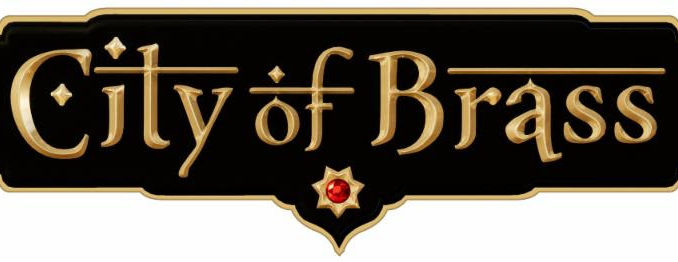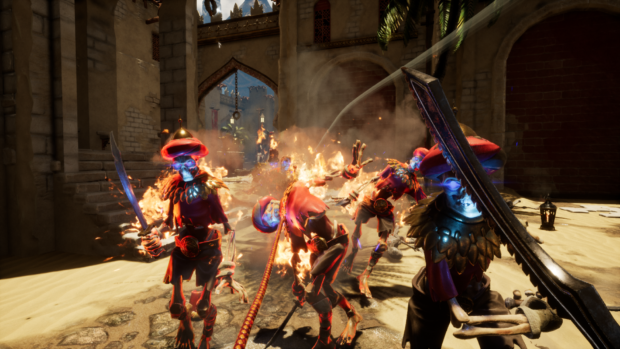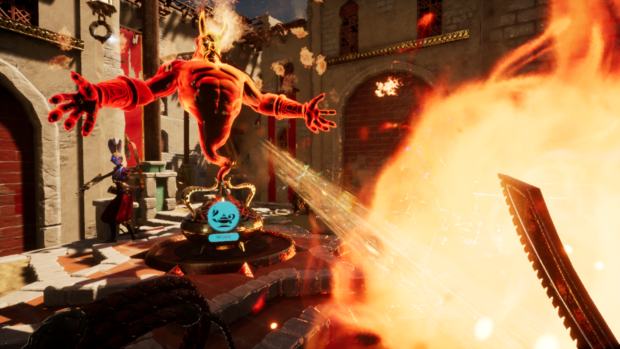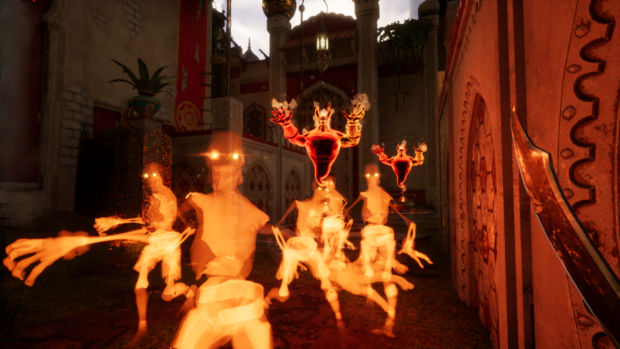
Brought to you by two members from the team that created Bioshock, a game that is considered to be a masterpiece of storytelling and level design, City of Brass is a vast departure from the linear style of the claustrophobic undersea adventure.
But that isn’t necessarily a bad thing.
The developers took this as a challenge and succeed in creating a convincing procedurally generated city of the dead.
Uppercut Games set out to create a procedurally generated world with the same believability and polish as Bioshock, where every detail of the world is painstakingly gone over to ensure top-notch level design. And to a certain degree, have done just that. Levels are saturated with things like spike traps and trap doors leading to pitfalls to keep you on your toes. Hidden golden items are littered throughout the world as well, giving you currency to spend at vendors for things like health, or a whip with a further reach. All of these things help make it feel as if the city, filled to the brim with things that want to kill you, is alive and dangerous.
 City of Brass is a Roguelike set in an Arabian Nights-style city filled with Genies, Zombies, and all sorts of other ghouls and ghosts. Almost as if Aladdin was directed by George A. Romero. The game starts with a tutorial to teach you the basic controls and mechanics of CoB, as well as provide some exposition as to why the player character is reincarnated after every death; which is a nice change to the standard “because it’s a video game.†You are then dropped at the outskirts of the “City of Brass†to either succeed in your goal of breaking the Genie’s curse, or spend an eternity trying.
City of Brass is a Roguelike set in an Arabian Nights-style city filled with Genies, Zombies, and all sorts of other ghouls and ghosts. Almost as if Aladdin was directed by George A. Romero. The game starts with a tutorial to teach you the basic controls and mechanics of CoB, as well as provide some exposition as to why the player character is reincarnated after every death; which is a nice change to the standard “because it’s a video game.†You are then dropped at the outskirts of the “City of Brass†to either succeed in your goal of breaking the Genie’s curse, or spend an eternity trying.
The two weapons you bring with you on your journey are a scimitar and a whip that the Belmonts would be proud of. Uppercut did a fantastic job creating a weapon that felt like it had actual force behind it. You can use it to stun your enemies, pull them in from afar, grab out of reach items, and as a grappling hook to cover large distances quickly. It’s a jack of all trades tool that makes the combat a pleasure. The scimitar, however, can only be described as inconsistent. it is hard to get a feel for its reach. You will often find yourself swinging at air, only to be brutally assaulted by a hulking behemoth, or blasted by a fireball from a spellcaster that you thought would have been caught in a stunlock animation. This problem could have been easily alleviated with an indicator that the enemy was in range, just like the one they use for the whip.
For those who don’t live by the “git gud†mentality, City of Brass provides a plethora of options to make the game easier. Such as removing the time limit from levels, starting you with increased health, or making your weapons do more damage. On the opposite side of the coin, there are also many options to increase the difficulty for those masochists who don’t think the game provides enough of a challenge. Unfortunately, despite the excellent combat, speedrunners will have an excellent time with this game, because running past every enemy to reach the end of the level as quickly as possible will often leave you unscathed, and unafraid of the challenges that lie ahead.
 Despite the developers best efforts, City of Brass does feature some of the drawbacks of procedural generation. While the city feels alive and oppressive, especially when night falls, you will often encounter similar setpieces as well as repeated textures. Also, you can hear the same moan and groan, or maniacal laugh only so many times before it becomes annoying rather than heart pounding.
Despite the developers best efforts, City of Brass does feature some of the drawbacks of procedural generation. While the city feels alive and oppressive, especially when night falls, you will often encounter similar setpieces as well as repeated textures. Also, you can hear the same moan and groan, or maniacal laugh only so many times before it becomes annoying rather than heart pounding.
Overall, Uppercut games succeeded in making a solid Roguelike with satisfying combat thanks to the best whip since Castlevania, and an interesting and unique setting. However generic enemies and subpar sound design are the games biggest drawbacks. It would have been nice to have background music to help set the tone and atmosphere of an otherwise fleshed out map, despite the normal shortcomings of a procedurally generated game.
The Good:
The Whip: The best part of City of Brass, the whip is an excellent example of weapon design that should be taken note of by developers on how to make a weapon feel like it has weight behind it.
 The Lore: Providing a backstory to a game that doesn’t necessarily need one adds a level of polish that makes a game feel more fleshed out and makes the world feel alive when you know why the city is in such a state of ruin.
The Lore: Providing a backstory to a game that doesn’t necessarily need one adds a level of polish that makes a game feel more fleshed out and makes the world feel alive when you know why the city is in such a state of ruin.
Difficulty Options: Whether too hard or too easy, City of Brass provides you with the choice to tailor the difficulty to your standards, a feature which will allow this game to be enjoyed by a wider audience.
The Bad:
Generic Enemy Design: Most enemies designs felt uninspired, boiling down for the most part to zombie this, zombie that, or in the case of minibosses, bigger zombie this, or bigger zombie that.
The Sword: In a game all about combating an onslaught of enemies while finding the end of the level, the most important thing is to make sure your weapons work as intended. With the shining example of the whip, the range issue with the sword shines even brighter.
 Final Thoughts:
Final Thoughts:
While City of Brass isn’t a revelation in the Roguelike genre, it is most certainly a solid game that deserves at least one playthrough. With a whip that would make Indiana Jones jealous and a simple yet effective backstory, Uppercut games can be proud of their first foray into the procedurally generated realm of gaming.


Leave a Reply